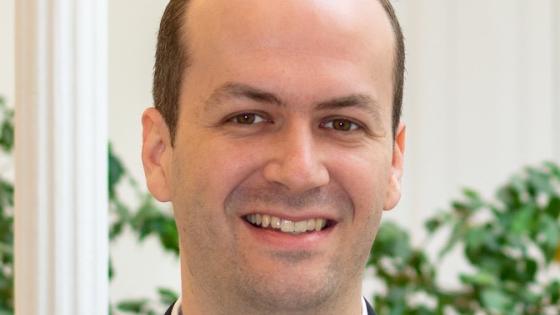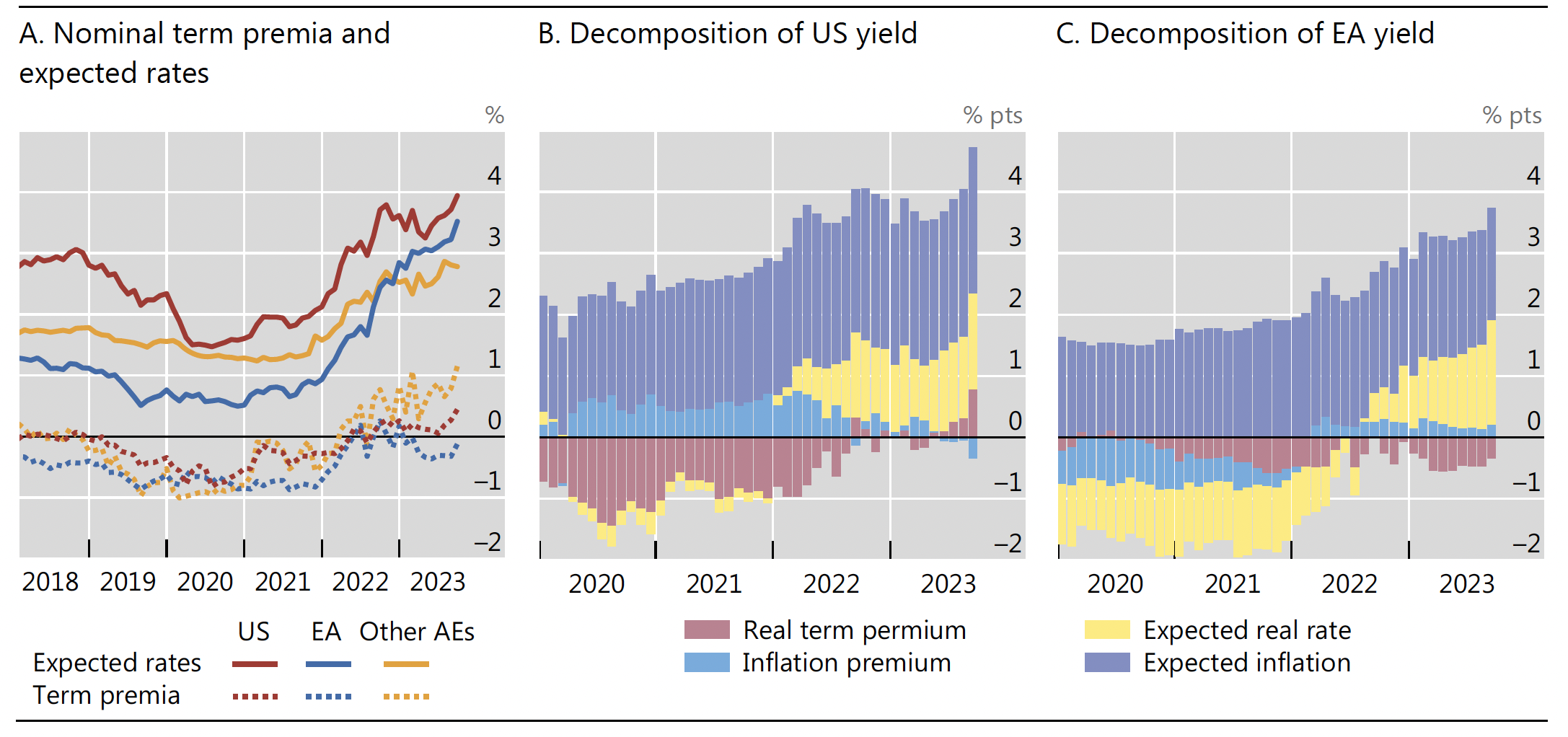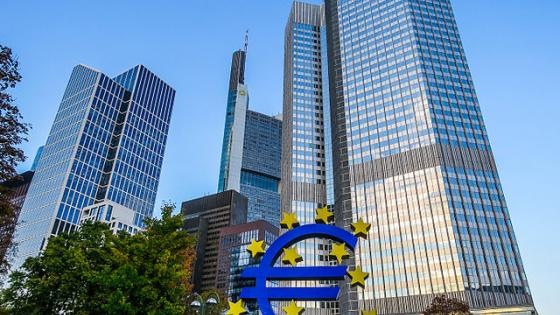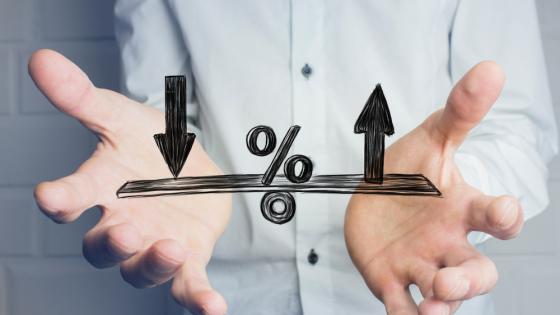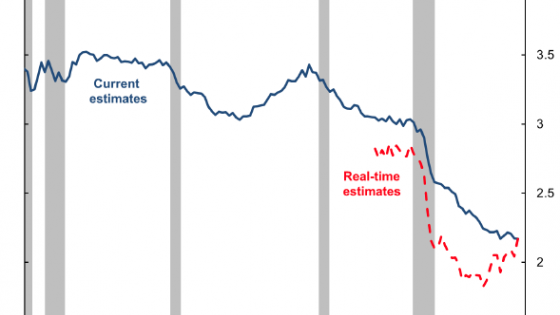Across most advanced economies, including the US and the euro area, nominal and real long-term bond yields have increased steeply since 2021 to their highest levels since more than a decade (Figure 1, panel A). Higher levels of the natural rates appear to have been a key driver of this development (panels B and C), although higher premia have also played a role.
Figure 1 Both expected future short-term rates and term premia have moved up since 2020
Notes: Decomposition of ten-year yield. For the US and euro area, estimates are based on the joint macroeconomic and term structure model of Hördahl and Tristani (2014); for other advanced economies, they are based on the term structure model of Joslin et al. (2011). Other advanced economies = Australia, Canada, Great Britain, and Sweden simple average.
Sources: Bloomberg; Refinitiv; BIS.
Understanding what drives the dynamics of the natural interest rates is very challenging, as they depend on multiple factors and are subject to a significant degree of uncertainty (Wieland and Michaelis 2017). Nonetheless, recent studies considering a broad set of estimates conclude that natural rates may have increased significantly from the historically low levels reached at the onset of the pandemic (e.g. Benigno et al. 2024, Brand et al. 2024).
The reasons for these increases are not entirely clear. While some standard drivers of the natural rates, such as productivity growth and demographics, do not seem to have changed much since 2019, the level of public debt has significantly increased worldwide following the fiscal expansion linked to the pandemic. In this column, we propose a complementary explanation: part of the surge in the natural rates is driven by the significant increase in long-term inflation expectations in the aftermath of the monetary policy strategy reviews of major central banks back in 2020-2021. As a result, the perceived likelihood of hitting the zero lower bound (ZLB) in the future has shrunk substantially.
Inflation expectations and the strategy reviews of 2021
The previous decade was characterised, from the perspective of central bankers, by the fear that a secular decline in natural rates would make the occurrence of zero lower bound episodes much more prevalent than previously anticipated. The problem with the ZLB is that it introduces an asymmetry in the conduct of monetary policy: while central banks can raise nominal interest rates as much as needed to prevent inflation from becoming entrenched, they cannot reduce them below zero except by a narrow margin. Consequently, deflationary pressures may be much harder to fight than inflationary ones.
Aware of that situation, the Federal Reserve and the European Central Bank (ECB) decided to revise their monetary policy strategies, with conclusions released in August 2020 (Federal Reserve) and July 2021 (ECB). Without entering in the details, these revisions made clear how central banks would try to counteract the deflationary impact of the zero lower bound (Ricco et al. 2021). The ECB, in particular, changed its inflation target from the vague “below but close to 2 percent” to the symmetric 2% objective that still exist today (ECB 2021).
The strategy seems to have worked, especially in the euro area, at least in terms of long-term inflation expectations. While expectations had plummeted below 2% since the sovereign debt crisis (Figure 2 panel A), they started to rise since mid-2020, and especially mid-2021, stabilising above 2%.
Figure 2 Higher inflation expectations may have raised natural rates
Notes: Panel B shows the effect on natural rates of an increase from 1.5% to 2.5% in long-term inflation obtained from a heterogeneous agent New Keynesian (HANK) model with a zero lower bound (ZLB) solved using global methods.
Sources: Fernández-Villaverde et al. (2024); Bloomberg; authors’ calculations.
It may be excessive to link this increase in expectations solely to central bank decisions: market participants might as well expect the transition to a regime characterised by greater inflation risk as a number of secular forces, including geopolitical risks, deglobalisation, and climate change may lead to structurally higher inflationary pressures going forward (Carstens, 2022). In any case, there has been a marked increase in long-term inflation expectations independently of its ultimate cause.
Inflation expectations and natural rates
The last piece of the puzzle is how higher inflation expectations lead to higher natural rates. In Fernandez-Villaverde et al. (2024) we quantify the link between long-term inflation, natural rates, and the frequency of zero lower bound episodes. We build a Heterogeneous-agent New Keynesian (HANK) model with a zero lower bound and solve it using a new global method based on neural networks.
This model exhibits a ‘deflationary bias’: the central bank can accommodate large positive demand shocks, as the nominal interest rate can go up as much as needed, but not large negative demand shocks, as the zero lower bound becomes binding. Thus, the economy will suffer more periods of deflation than it would in the absence of the zero lower bound, and the central bank will undershoot its inflation target. Agents respond to this by increasing their precautionary savings, as they - especially the poorer ones - suffer more during recessions at the zero lower bound.
Higher precautionary savings lowers real rates: higher demand for savings given the same supply of bonds in our economy translates into higher prices for bonds, i.e. lower rates.
Since the long-term nominal interest rate is just the real interest rate plus inflation, the average nominal rate is lower, providing less room for the central bank to stabilise the economy away from the zero lower bound.
Contrary to the view held among classical economists, monetary policy is not neutral in the long run in this model. Low long-term inflation expectations lead to lower nominal interest rates, which in turn means more frequent zero lower bound episodes. This reduces natural rates through precautionary savings, depressing nominal rates even more.
If the central bank manages to increase long-run inflation expectations (or they increase due to other reasons), this vicious cycle can be reversed: higher inflation expectations open the door to higher natural and nominal rates and reduce fears of the zero lower bound becoming entrenched. This is what we argue may have happened in the last three years. A rough quantification of an increase in long-term inflation expectations from 1.5% to 2.5% due to a higher perceived inflation target yields a rise in the natural rate of more than 20 basis points.
Concluding remarks
Major central banks committed in their last strategy reviews to counteract the deflationary bias associated with the zero lower bound. Economic theory predicts that this should have led to higher long-term inflation expectations and higher natural rates. Recent evidence seems to support these predictions. If that is the case, that is a lesson to be remembered in the future round of strategy reviews.
Authors’ note: The views expressed here are exclusively those of the authors and do not necessarily represent the views of the BIS, the Bank of Spain, or the Eurosystem.
References
Adam, K and R M Billi (2007), “Discretionary monetary policy and the zero lower bound on nominal interest rates”, Journal of Monetary Economics 54(3): 728– 752.
Benigno, G, B Hofmann, G Nuno and D Sandri (2024), “A rising star? The natural rate of interest after the pandemic”, BIS Quarterly Review, March.
Bianchi, F, L Melosi and M Rottner (2021), “Hitting the elusive inflation target”, Journal of Monetary Economics 124: 107–122.
Brand, C, N Lisack and F Mazelis (2024), “Estimates of the natural interest rate for the euro area: an update”, ECB Economic Bulletin 1.
Carstens, A (2022), “The return of inflation”, Speech given at the International Center for Monetary and Banking Studies, Geneva, 5 April.
European Central Bank (2021), “ECB’s Governing Council approves its new monetary policy strategy”, press Release, 8 July.
Fernández-Villaverde, J, J Marbet, G Nuno and O Rachedi (2024), "Inequality and the Zero Lower Bound", Banco de Espana Working Paper.
Hördahl, P and O Tristani (2014), “Inflation risk premia in the euro area and the United States”, International Journal of Central Banking 10(3): 1–47.
Joslin, S, K J Singleton and H Zhu (2011), “A New Perspective on Gaussian Dynamic Term Structure Models”, The Review of Financial Studies 24(3): 926-970.
Nakov, A (2008), “Optimal and simple monetary policy rules with zero floor on the nominal interest rate”, International Journal of Central Banking 4: 73–127.
Platzer, J, R Tietz, and J Lindé (2022), “Natural versus neutral rate of interest: Parsing disagreement about future short-term interest rates”, VoxEU.org, 26 July.
Ricco, G, R Reis, L Reichlin, M Mcmahon, W Mckibbin and K Adam (2021), “The ECB strategy: The 2021 review and its future”, VoxEU.org, 1 September.
Wieland, V and H Michaelis (2017), “R-Star and the Draghi rules: Correctly measuring the equilibrium interest rate for policy use”, VoxEU.org, 12 May.
Woodford, M (2003), Interest and prices: foundations of a theory of monetary policy, Princeton University Press.


